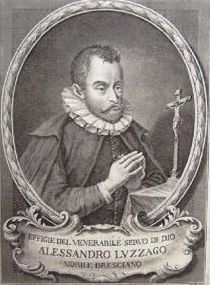Life
Luzzago was the son of Girolamo Luzzago and Paola Peschiera. He was baptised on November 8 in the Church of Santa Maria in Calchera. [1] The Luzzago family was one of the most important noble families of Brescia. His mother was an early collaborator of Saint Angela Merici. [2]
Luzzago received his first formation at Gavardo under the priest Marcantonio Roccio. [3] From 1570, he studied philosophy with the Jesuits at the Convent of San Antonio. On 25 and 26 October 1573 he defended his thesis, In universam philosophiam cum practicam tum speculativam necnon in logicam veterum aeque ac recentium philosophorum sententiae et theoremata varia publice discutienda (Brescia, 1573). [3] Between 1578 and 1582, with the help of Saint Charles Borromeo, he studied theology with the Jesuits at the Palazzo Brera in Milan. [1] In 1586 he received the clerical tonsure which was required for him to receive the doctorate in philosophy and theology from the University of Padua. [3] Luzzago was eager to join the Jesuits, but he was prevented from doing so on account of the economic difficulties of his family, caused by some inappropriate transactions by his father. [1]
In 1584, Luzzago became of member of Brescia's city council and he began his work to harmonize the relationships between the city government and various church charitable organisations. [1] In 1595 he was appointed curator of the Monti di Pietà in Brescia. [1] In 1597 he was elected protector of the Compagnia delle Dimesse di Sant' Orsola and of two other charitable institutes in Brescia: the Soccorso and the Zitelle. [1] He reorganized and gave new impetus to the city's revised catechetical programme which arose after the Council of Trent. [1] For the students he founded the Congregation of Saint Catherine of Siena. To ensure that his work continued, he founded the Congregation of the Holy Spirit, which gathered the members of the city's ruling class with the aim of cooperating more effectively in supporting all charitable institutions. [1]
In 1589, Luzzago accompanied to Rome Cardinal Gianfrancesco Morosini, who was bishop of Brescia and papal nuncio to France. [1] During this trip to Rome he studied the various church charities in Rome which he later proposed in Brescia. He also had the opportunity to meet Saint Philip Neri. [1] In a 1595 letter from Morosini's secretary, Luzzago was informed that Pope Clement VIII was considering him as the next archbishop of Milan.
Luzzago fell sick on 3 May 1602 and died on 7 May. [1] After his funeral in Milan, his body was buried in the church of Santa Barnaba in Brescia. [1] In 1878 his remains were transferred to the church of Santa Maria della Pace in Bresica, where they still remain today. [1]
Luzzago is a collateral ancestor of Fra' Marco Luzzago.

Pope Leo XI, born Alessandro Ottaviano de' Medici, was head of the Catholic Church and ruler of the Papal States from 1 April 1605 to his death, on 27 April 1605. His pontificate is one of the briefest in history, having lasted under a month. He was from the prominent House of Medici originating from Florence. Medici's mother opposed his entering the priesthood and sought to prevent it by having him given secular honours, but after her death he eventually was ordained a priest in 1567. In his career he served as Florence's ambassador to the pope, Bishop of Pistoia, Archbishop of Florence, papal legate to France, and as the cardinal Prefect for the Congregation of the Bishops and Religious. He was elected to the papacy in the March 1605 papal conclave and served as pope for 27 days.

Charles Borromeo was the Archbishop of Milan from 1564 to 1584 and a cardinal of the Catholic Church. He was a leading figure of the Counter-Reformation combat against the Protestant Reformation together with Ignatius of Loyola and Philip Neri. In that role he was responsible for significant reforms in the Catholic Church, including the founding of seminaries for the education of priests. He is honoured as a saint by the Catholic Church, with a feast day on 4 November.
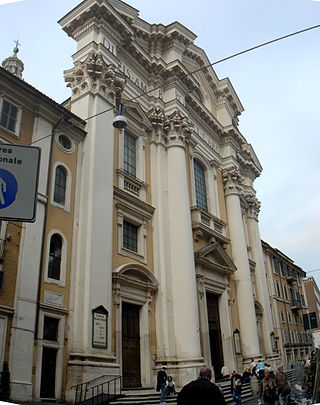
Sant'Ambrogio e Carlo al Corso is a basilica church in Rome, Italy, facing onto the central part of the Via del Corso. The apse of the church faces across the street, the Mausoleum of Augustus on Via di Ripetta.

Alessandro Farnese, an Italian cardinal and diplomat and a great collector and patron of the arts, was the grandson of Pope Paul III, and the son of Pier Luigi Farnese, Duke of Parma, who was murdered in 1547. He should not be confused with his nephew, Alessandro Farnese, Governor of the Spanish Netherlands, grandson of Emperor Charles V and great-grandson of Pope Paul III.

Federico Borromeo was an Italian cardinal and Archbishop of Milan, a prominent figure of Counter-Reformation in Italy.

The Basilica of Saint Praxedes, commonly known in Italian as Santa Prassede, is an early medieval titular church and minor basilica located near the papal basilica of Saint Mary Major, on Via di Santa Prassede, 9/a in rione Monti of Rome, Italy. The current Cardinal Priest of Titulus Sancta Praxedis is Paul Poupard.

Ventura di Archangelo Salimbeni was an Italian Counter-Maniera painter and printmaker highly influenced by the vaghezza and sensual reform of Federico Barocci.
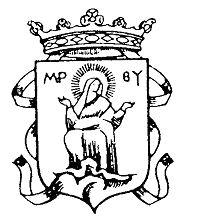
The Clerics Regular of the Mother of God is a religious order of clerics regular of pontifical right. Its priests are dedicated to education and pastoral care. The Order was founded by St. John Leonardi, who worked with this congregation to spread devotion to the Blessed Virgin Mary, as well as the Forty Hours devotion, and frequent reception of the Blessed Sacrament.

The Diocese of Brescia is a Latin diocese of the Catholic Church in the ecclesiastical province of the Metropolitan Archdiocese of Milan, in Lombardy.

Santa Maria in Vallicella, also called Chiesa Nuova, is a church in Rome, Italy, which today faces onto the main thoroughfare of the Corso Vittorio Emanuele and the corner of Via della Chiesa Nuova. It is the principal church of the Oratorians, a religious congregation of secular priests, founded by St Philip Neri in 1561 at a time in the 16th century when the Counter Reformation saw the emergence of a number of new religious organisations such as the Society of Jesus (Jesuits), the Theatines and the Barnabites.

Paolo Burali d'Arezzo was an Italian priest of the Theatine Order, a bishop, and cardinal of the Roman Catholic Church. His legal skills made him a prominent figure in the law courts of Naples, and then in the councils of government as a defender of the rights of citizens. He abandoned his career to pursue a calling to the religious state, where he became a leader in the Theatine Order. Pope Pius V elevated him to the cardinalate in 1570. He was considered a candidate for the Papacy in 1572, but his stern character did not recommend him to the electors. The new Pope, Gregory XIII, then promoted him to be the Archbishop of Naples, where he served from 1576 to 1578. After his death, he was recognized as beatified and worthy of official recognition by the Church.
The Pelagians were a lay confraternity founded in the church of Santa Pelagia in Milan by the seventeenth century Giacomo Filippo di Santa Pelagia, an Italian lay mystic. Although initially approved of by Roman Catholic authorities, the group was later condemned for alleged heretical practices associated with Quietism.
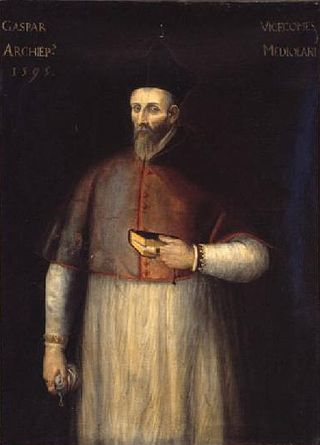
Gaspare Visconti was the Archbishop of Milan from 1584 to 1595.

Ramiro Rampinelli, born Lodovico Rampinelli, was an Italian mathematician and physicist. He was a monk in the Olivetan Order. He had a decisive influence on the spread of mathematical analysis, algebra and mathematical physics in the best universities of Italy. He is one of the best known Italian scholars in the field of infinitesimal mathematics of the first half of the 18th century.
Bernardino Morra was a Roman Catholic prelate who served as Bishop of Aversa (1598–1605).
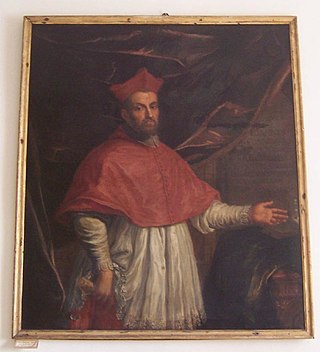
Giovan Francesco Morosini or Gianfrancesco Morosini was a Venetian Catholic cardinal who served as Bishop of Brescia and Apostolic Nuncio in France.
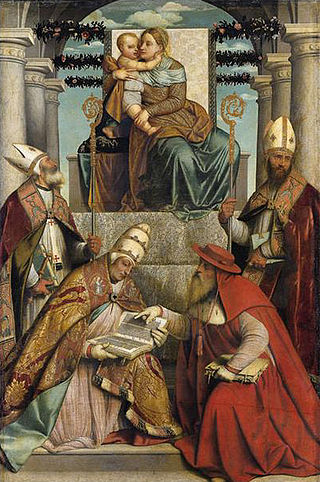
Madonna and Child with Four Doctors of the Church is a 1540-1545 oil on canvas painting by Moretto da Brescia, now in the Städelsches Kunstinstitut in Frankfurt. From left to right it shows Saint Ambrose, Gregory the Great, Saint Jerome and Augustine of Hippo.
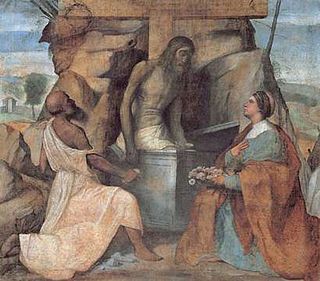
The Dead Christ Adored by Saint Jerome and Saint Dorothy or Saint Jerome and Saint Dorothy Adoring Christ in the Tomb is a 1520-1521 tempera verniciata on canvas painting by Moretto da Brescia. It is on show above the left-hand side door to the church of Santa Maria in Calchera in Brescia, though it is not thought to have originally been produced for that church as neither Jerome nor Dorothy had an active cult in that parish and they rarely appear in art together.

The Pontifical Lombard Seminary of Saints Ambrose and Charles in Urbe is an ecclesiastical institution that serves as a residence for and trains diocesan priests who have been sent to Rome by their bishop to pursue an advanced degree or follow a specialized course of study at one of the pontifical universities there.

Antonio Querenghi or Quarenghi was an Italian lawyer, theologian and poet. A native of Padua, he belonged to the same intellectual circle as Galileo. Most of his career was spent in Rome, where he served several cardinals and popes. He composed poetry in both Neo-Latin and the Italian vernacular.
